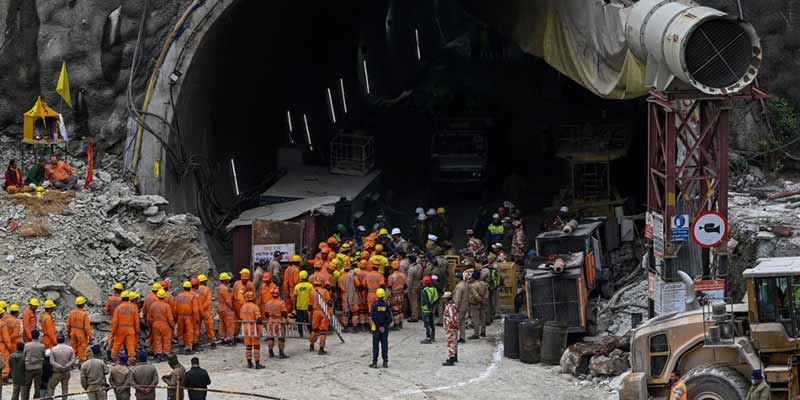- India
- Nov 29
Explainer - Why NGT banned ‘rat-hole mining’ in Meghalaya?
• Rescue workers pulled out all 41 workers trapped in Uttarakhand’s Silkyara tunnel on November 28 after 17 days of a multi-agency operation conducted by the central and state governments.
• A portion of the under-construction tunnel on Uttarakhand’s Char Dham route collapsed on November 12, blocking the exit of the workers who were inside.
• Food, medicines and other essentials were sent to them through a six-inch pipe pushed through the debris.
• The final challenge in the rescue operation was tackled by a group of men versed in the technique of “rat-hole mining”.
• They were called in to carry out manual drilling after a huge American-made auger boring machine got stuck in the horizontal passage that had been dug up to about 47 meters, the latest in a serious of snags as its blades encountered hurdles like iron girders.
• The rat-hole mining experts worked in groups of two or three at a time in the confined space using hand-held tools at the end of the 800-mm wide steel pipe.
What is rat-hole mining?
• Small-scale coal mining in Meghalaya started in the 19th century during British rule.
• Coal mining began to flourish in 1970s in Khasi and Jaintia Hills regions as the extracted coal found uses in Assam in tea estates and brick kilns. Later, coal mining was started in Garo Hills.
• Large-scale coal mining began in Meghalaya in 1980s. Jaintia Hills region was recognised as a major coal producing area. Coal was marketed and transported to different parts of India and also exported to Bangladesh.
• Coal deposited in thin seams imbedded in sedimentary rocks, sandstones and shale, is extracted manually by making narrow tunnels either through the side of the hill (referred to as side-cutting) or through a rectangular shaft/pit (known as box-cutting).
• The tunnels being narrow are referred to as “rat holes” and the mining method is commonly known as “rat-hole mining”.
• Rat-hole mining involves digging of narrow tunnels, usually 3-4 feet high, for workers to enter and extract coal. The horizontal tunnels are often termed rat holes, as each just about fits one person.
• In side-cutting, a hole is cut from the side of the hill where coal seam is visible from outside or where there is a possibility of locating a coal seam. Through a narrow tunnel, the miners explore the inside of the hill for coal and if found, extract it manually through small implements.
• In both side-cutting and box-cutting methods, the miners enter/crawl into the tunnel and extract the coal with a small shovel. The extracted coal is brought from the tunnel into the shaft/pit by using a conical basket or a wheelbarrow.
• The coal is then taken out of the pit either manually or with the help of a small crane.
Environmental impact of coal mining in Meghalaya
• Mining in coal mines in Meghalaya starts in the month of September and continues till onset of monsoon in May. Mining is initiated by draining of water accumulated in the mines during monsoon months. Such water is collected in a small sump/tank constructed at bottom of the mine shaft/box cutting, and is periodically drained out by using electric/diesel operated pumps.
• Quantity of water which is required to be drained for continuation of mining operations in a typical mine during winter months is about 10,000 litres per day.
• During the monsoon season, it is not possible to drain large quantities of water accumulated in these mines. The mining in such mines is therefore temporarily suspended during the monsoon season.
• Due to very high sulphur content (about 5 per cent) in Meghalaya coal, water accumulated in rat hole mines is highly acidic and has pH as low as 1.5. Such highly acidic water is drained into nearby areas from where it finds its way to nearby streams/rivers. Most rivers/streams in coal mining affected areas in the state are highly polluted and have pH as low as 2.
• The coal extracted from these mines is stored in open depots. During the rains, the sulphur available in the coal gets dissolved in the rain water. The highly acidic rain water originating from these depots finds its way to nearby streams resulting in the pollution/degradation of the land on its way and the streams into which it drains.
• Construction of mine shafts/openings, storage of coal and overburden, construction of approach roads and coal depots has resulted in destruction of flaura, fauna and forests.
• All such coal mining in Meghalaya has been undertaken in a haphazard, unscientific and unsafe manner without obtaining any approval from authorities under any mining, environmental and labour safety laws.
• Absence of any safety measures has resulted in a number of very tragic accidents resulting in loss of many human lives and injuries. Many of these accidents go unreported.
• In July 2012, on account of lack of safety norms, 30 coal labourers were trapped inside a coal mine at Nongalbibra in South Garo Hills district and 15 of them died.
• In April 2014, the National Green Tribunal in 2014 imposed a ban on coal mining using the rat-hole mining technique in Meghalaya in the light of scientific studies.
• Though rat-hole mining has been banned in Meghalaya since 2014, the practice reportedly continues illegally.
• In December 2018, 15 miners died when an illegal “rat-hole” mine at Ksan got flooded by water from the Lytein river nearby.
Manorama Yearbook app is now available on Google Play Store and iOS App Store


